The following are “Core Exercises” that are prescribed by the Chiropractors at ProCARE Chiropractic in Olathe/Overland Park during your treatment to ensure optimal recovery from your accident, injury or painful condition. These exercises are used to strengthen and increase endurance of the spinal and abdominal musculature which forms what is commonly referred to as “the core”. These exercises have been studied and published in the literature and have proved to provide a muscular challenge to the “core” while still sparing the spine. These exercises should form the foundation of any spinal stability program. To insure the best results and fastest recovery from your injury, these back exercises will be combined with spinal/extremity adjusting and stretching.
Back Pain Patients Please Note:
These exercises and pictures are meant only to help our patients remember key points and positions of an exercise that has been prescribed to them for performance at home.
Please do not attempt to perform these exercises or advance to a more difficult version without first consulting your Chiropractor in our office. Doing so may delay healing and prevent progress.
Thank You, Drs Toby and Molly Scott
Side Bridge
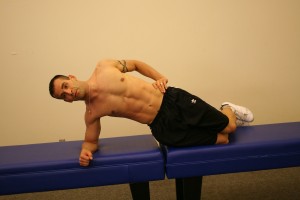
Beginner Side Bridge
The Beginner Side Bridge is a great exercise to start to stabilize the spine. This exercise has been extensively studied by Stuart McGill and has been shown to challenge all of the muscles of the “core” while minimizing stress to the lumbar spine and discs. The patient should be able to perform 3 sets of 5 repetitions before moving on to a more advanced position. Each repetition should be held for 8 seconds.
Key points:
Shoulders, hips and knees should all be in a straight line.
Gluteal (butt) muscles should be contracted
Hold each repetition for 8 seconds
The neck and back should be straight
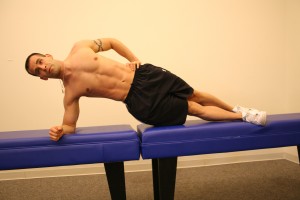
Advanced Side Bridge
Above is an example of an advanced side bridge. This is often used as a functional test. A patient who can not perform a minimum of a 45 second hold has been shown to be at an increased risk for low back pain. The training goal should be to increase endurance to allow the patient to hold this position during a test for 90 seconds or more.
Note: There is a small mistake in the above picture, the patient should have the top leg in front of the bottom instead of behind as pictured.
Key points:
The hips, knees, ankles,shoulders and neck should all be in a straight line
Perform a contraction/brace of all the abdominal muscles
Hold each repetition for 8 seconds
Work up to 3 -5 sets of 10-12 repetitions
Front Bridge
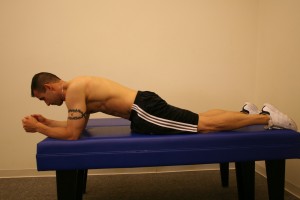
Beginner Front Bridge
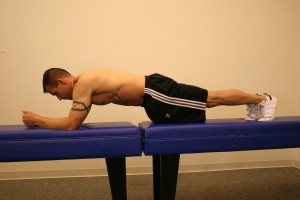
Advanced Front Bridge
The front bridge exercise is first started from the knees (as shown above in Beginner Front Bridge) and progressed by lengthening the space between the floor contact points. Typically when the patient can perform 3-5 sets of 5-10 repetitions of 8 second holds they are progressed to the feet as shown directly above.
Key Points:
Keep a neutral spinal position with the back and neck in a straight line
Perform a spinal brace contracting the abdominal and back muscles
8 second hold times for each repetition
Caution should be used to ensure the spine is held in a neutral position to avoid extra pressure on the posterior facet joints.
Bird Dog
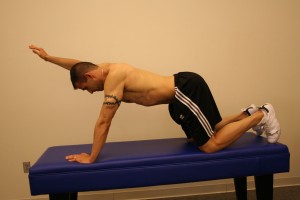
Bird Dog Exercise
The BirdDog exercise is another one of Stuart McGill’s core exercises. This exercise is designed to work the back paraspinal muscles along with the other core muscles. This exercise is a key exercise for stabilizing the spine and tying together the lower back and upper back.
Key Points
Start on the hands and knees
Keep the back and neck in a neutral position and perform movements slowly and in control
Resist the tendency of the back, hips or shoulders to twist or shift to either side while lifting an arm from the floor, alternate lifting the arms
Progression can be made when the patient can raise an arm for a 5 second hold time multiple times without any rotation or shifting of the spine, hips or shoulders.
Progress to extending the hip and alternating lifting the legs.
A further progression would be to alternate lifting the opposite leg and arm. This is a very advanced move and few people can perform this with proper body position.
Hip exercises/upper body drills
If you experience an increase in back symptoms during any of these exercises please discontinue and consult your chiropractor.
